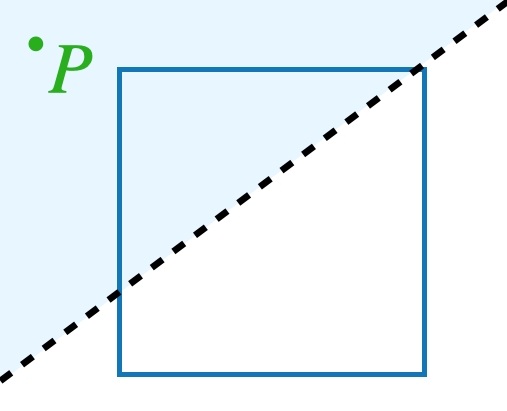Problems
A \(1 \times 10\) strip is divided into unit squares. The numbers \(1, 2, \dots , 10\) are written into squares. First, the number 1 is written in one square, then the number 2 is written into one of the neighboring squares, then the number 3 is written into one of the neighboring squares of those already occupied, and so on (the choice of the first square is made arbitrarily and the choice of the neighbor at each step). In how many ways can this be done?
Imagine an infinitely large sheet of paper with a square drawn on it. Somewhere on the paper, a point \(P\) is marked with ink that is invisible to you. However, a friend with a special pair of glasses can see the point.
We are allowed to draw straight lines on the paper, and for each line, our friend will tell us on which side of the line the point \(P\) is. (If \(P\) is exactly on the line, they will say so.) For example, on this picture, our friend would say that the point \(P\) is above the line we’ve drawn:

What is the smallest number of such questions that are needed in order to be certain whether \(P\) lies inside the square? Explain why it cannot be done in less questions then you are suggesting.
Two play tic-tac-toe on a \(10 \times 10\) board according to the following rules. First they fill the whole board with noughts and crosses, putting them in turn (the first player puts crosses, their partner – noughts). Then two numbers are counted: \(K\) is the number of five consecutively standing crosses and \(H\) is the number of five consecutively standing zeros. (Five, standing horizontally, vertically and parallel to the diagonal are counted, if there are six crosses in a row, this gives two fives, if there are seven, then three, etc.). The number \(K-H\) is considered to be the winnings of the first player (the losses of the second).
a) Does the first player have a winning strategy?
b) Does the first player have a non-losing strategy?
Initially, on each cell of a \(1 \times n\) board a checker is placed. The first move allows you to move any checker onto an adjacent cell (one of the two, if the checker is not on the edge), so that a column of two pieces is formed. Then one can move each column in any direction by as many cells as there are checkers in it (within the board); if the column is on a non-empty cell, it is placed on a column standing there and unites with it. Prove that in \(n - 1\) moves you can collect all of the checkers on one square.
A cube with side length of 20 is divided into 8000 unit cubes, and on each cube a number is written. It is known that in each column of 20 cubes parallel to the edge of the cube, the sum of the numbers is equal to 1 (the columns in all three directions are considered). On some cubes a number 10 is written. Through this cube there are three layers of \(1 \times 20 \times 20\) cubes, parallel to the faces of the cube. Find the sum of all the numbers outside of these layers.
In a regular polygon with \(25\) vertices, all the diagonals are drawn.
Prove that there are no nine diagonals passing through one interior point of the shape.
17 squares are marked on an \(8\times 8\) chessboard. In chess a knight can move horizontally or vertically, one space then two or two spaces then one – eg: two down and one across, or one down and two across. Prove that it is always possible to pick two of these squares so that a knight would need no less than three moves to get from one to the other.
A group of psychologists developed a test, after which each person gets a mark, the number \(Q\), which is the index of his or her mental abilities (the greater \(Q\), the greater the ability). For the country’s rating, the arithmetic mean of the \(Q\) values of all of the inhabitants of this country is taken.
a) A group of citizens of country \(A\) emigrated to country \(B\). Show that both countries could grow in rating.
b) After that, a group of citizens from country \(B\) (including former ex-migrants from \(A\)) emigrated to country \(A\). Is it possible that the ratings of both countries have grown again?
c) A group of citizens from country \(A\) emigrated to country \(B\), and group of citizens from country \(B\) emigrated to country \(C\). As a result, each country’s ratings was higher than the original ones. After that, the direction of migration flows changed to the opposite direction – part of the residents of \(C\) moved to \(B\), and part of the residents of \(B\) migrated to \(A\). It turned out that as a result, the ratings of all three countries increased again (compared to those that were after the first move, but before the second). (This is, in any case, what the news agencies of these countries say). Can this be so (if so, how, if not, why)?
(It is assumed that during the considered time, the number of citizens \(Q\) did not change, no one died and no one was born).
A square is cut by 18 straight lines, 9 of which are parallel to one side of the square and the other 9 parallel to the other – perpendicular to the first 9 – dividing the square into 100 rectangles. It turns out that exactly 9 of these rectangles are squares. Prove that among these 9 squares there will be two that are identical.
In a row there are 2023 numbers. The first number is 1. It is known that each number, except the first and the last, is equal to the sum of two neighboring ones. Find the last number.